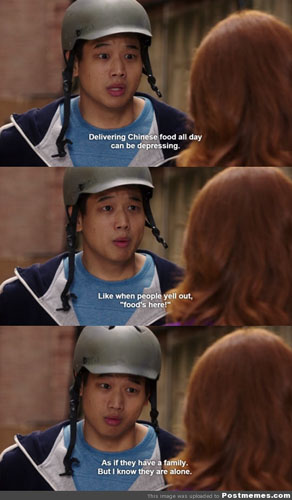
Image Credit:
Post Memes. "One of My Favorite Moments From Unbreakable Kimmy Schmidt." Flickr. Flickr, 23 Mar 2015. Web. 17 Apr 2015.
Since I’ve begun teaching, I have frequently described moments in the classroom in terms of trains. A lesson depends upon organic human interaction, and sometimes the best laid plans can produce unexpected results. So, when it comes to lesson-planning, I tend to be an overplanner as a means of minimizing the chances of derailment. That said, asking students to rhetorically analyze a deliberately racist yet humorous text is about as high stakes as this risk of derailment gets.
Since I’ve begun teaching, I have frequently described moments in the classroom in terms of trains. A lesson depends upon organic human interaction, and sometimes the best laid plans can produce unexpected results. So, when it comes to lesson-planning, I tend to be an overplanner as a means of minimizing the chances of derailment, and I can happily say that this works for me.
That said, asking students to rhetorically analyze a deliberately racist yet humorous text is about as high stakes as this risk of derailment gets. Knowing this and knowing that for a number of reasons I believe it is important to ask them to do so, I went about structuring this lesson with caution. First, I selected a timely, accessible, and frankly funny text that is in the midst of making some waves in the media—the new Netflix sitcom produced by Tina Fey called The Unbreakable Kimmy Schmidt. This show seemed to me like an ideal entry point for analyzing and discussing sensitive material because it is a colorful, fast-paced, and somehow thoroughly lighthearted sitcom that directly takes on dark topics that range from kidnapping and PTSD to 21st-century racism in the US.
For this lesson (which we resumed intermittently with different purposes throughout the semester), I had students first read a brief online article that softly critiques the show’s deliberate racism. Next, I had them view a few brief clips that best represented the argument that this author was making. In groups, I then had them identify the main claim in the article that they read, as well as respond to that claim with their own reasoning and evidence.
My purpose in doing this activity was fourfold. First, I wanted the students to practice creating a rhetorical analysis between a primary and secondary source because they were currently in the midst of revising a written, individual analysis of this kind. I also wanted the students to experience how others would go about assessing the same two texts so that they could reflect a bit more critically on changes that they might make in their own writing. Third, this lesson ideally would demonstrate to the students that it is possible to thoughtfully talk about sensitive topics such as racist comedy, and a great way of doing so is through rhetorical analysis. Lastly, I hoped that my students would see that performing such an analysis can be interesting and fun, as evidenced by the combination of a Netflix sitcom and a brief critique from a website that they probably visit on their own time.
Like I said, my students were on-board with all of this. They loved the show, and they gave interesting and thoughtful responses from start to finish. Nevertheless, I found myself combatting an everpresent fear throughout the lesson that at any moment, it would become clear that I had put us onto a train with no brakes, and we’d all soon be hurtling down an unfinished track to a messy, (thankfully) metaphorical demise.
What I have realized upon reflection is what I have known all along: the track is always unfinished. As we who research rhetoric know, invention is a core feature of the discipline. Everyday we are inventing in the sense that we are adapting our responses to different circumstances, needs, and goals. As an instructor, I want to give my students the tools that they need in order to respond well to those circumstances. As my students have shown me, they are certainly capable of doing so.
Yes, asking students to discuss racism is going to be uncomfortable on some level because racism is no light matter, and we should not take it lightly. Yes, I will continue to be on high-alert for the moment in which a class discussion might be getting onto the wrong track. However, that possibility is always present in the classroom. What I’ve seen wonderfully demonstrated through this lesson is that my student-passengers are there because they want to get to the destination, too, and I can trust them to get along with each other as we make our way down the track that we are creating together.

